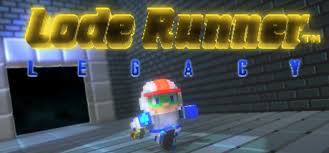Developed by Tozai, the same studio behind the Switch title Minna de Wai Wai! Spelunker, Lode Runner Legacy is a (as of now) PC exclusive title which attempts to bring the classic Hudson Soft franchise to the 21st century.
If you’re not acquainted to Lode Runner games (like me before reviewing this game), they are very simple in concept: your goal is to collect all items in the level while avoiding being touched by enemies. You can climb ladders, hang on ropes and destroy blocks set diagonally next to you, but you cannot jump, therefore every single move must be precisely planned in order for you not to get stuck in a pit. Once you get all the items, you need to reach a ladder and proceed to the next map. That’s pretty much everything you could do in the original Lode Runner, and it’s still all you can do in Lode Runner Legacy.
In terms of sticking to its roots, Lode Runner Legacy does wonders. It looks like the original, plays (mostly) like the original, feels like the original, and even includes a polygonal version of the original game in it. If you’re a fan of the series, you’ll most likely love the nostalgia bomb that it’ll be for you. If you’re not a fan of it, however, or if you have absolutely no nostalgia whatsoever towards this series, you’ll quickly notice a wide array of flaws present in it.
Legacy‘s flaws walk right next to its strongest aspects. Its visuals are a great polygonal recreation of the original 1983 Lode Runner. Despite this, the game gets visually repetitive pretty quickly, especially when it comes to its backgrounds and lack of variety. Lode Runner had repetitive backgrounds due to limited hardware capabilities back in 1983, not because the developers wanted them. Lode Runner Legacy retains all the visual limitations from the older games as an artistic choice, and this is not as pleasing for the eyes as the developers may have imagined.
The same applies for gameplay: Lode Runner Legacy retains pretty much the same gameplay from 1983, and that’s generally a good thing, but it also showcases a few irritating flaws. For starters, one of the new additions to the game is a bizarre first person camera which renders the game completely unplayable. Have you ever seen any Youtube videos of Minecraft or Unreal engine enthusiasts recreating 2D Mario levels as a 3D first person game. Legacy‘s first person mode is as ugly and confusing to play as those videos. Its biggest flaw, however, is the fact you can only dig at one set direction, either left or right. If you want to swap your directions, you need to pause the game, enter the options menu, and then change the digging direction. A PC keyboard has tons of inputs, and the same can be said for the Xbox One controller, whoever thought this was a great design idea deserves shame. Once again, you don’t need to go full retro by using just two buttons, there were few inputs back then due to limitations, not due to choice.
One great redeeming aspect in Lode Runner Legacy is its various editors. You can pretty much create everything in this game, like a brand new character, levels, and even items. You can easily customize the game to your tastes, creating any polygonal character you can imagine (I’ve already seen 8-bit Marios and Links around), as well as creating and sharing levels online. While Lode Runner Legacy‘s gameplay isn’t anything special at all, its creation tools are definitely worth checking out, and add quite a bit of replayability to an otherwise underwhelming package.
The editors are indeed very fun to use
Overall, Lode Runner Legacy is far from being a bad game, but it suffers from some unforgivable flaws and the fact it was clearly released on the wrong platform. Lode Runner Legacy would have been a perfect fit for a console like the Switch or the Vita, given how you can hardly keep on playing the game for more than 15 minutes at a time. While it was great to see yet another old franchise receive a new iteration in this day and age, I can’t help but feel slightly disappointed by the end product.

